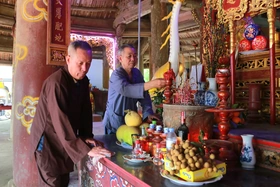{title}
{publish}
{head}

baophutho.vn The traditional art of creating skirt patterns among the Muong people, originally in Hoa Binh province, now part of Phu Tho province, has been...

baophutho.vn The Ministry of Culture, Sports, and Tourism has officially released the latest List of National Intangible Cultural Heritages, with the newly...

baophutho.vn With the desire not only to preserve the cultural space of the ancient Muong people but also to build a high-quality tourism destination rich...

baophutho.vn Phu Tho—the land of national origins—is home to more than 1,064 valuable historical and cultural relics. In recent years, efforts to enhance...

baophutho.vn For generations, ethnic minority communities in Thanh Son District have steadfastly preserved their traditional cultural values—woven deeply...

baophutho.vn In Yen Luong Commune, Thanh Son District, the only Tho ethnic community in Phu Tho Province has lived in harmony and unity for over half a...

baophutho.vn In recent years, Tan Son District has consistently prioritized the preservation and promotion of the traditional cultural values of its ethnic...

baophutho.vn Thanh Son, a mountainous district in Phu Tho province, is home to a large ethnic minority population, primarily the Muong and Dao communities....

baophutho.vn On the evening of April 27, the exhibition titled “Tourism Space, Cultural Heritage, Scenic Spots, and Traditional Handicraft Products of...

baophutho.vn Cassava cake has long been a beloved specialty of the people in the Land of the Hung Kings. Each region, and even each household, has its own...

baophutho.vn Implemented in 2023, the project “Introducing the musical heritage of Xoan singing” by music researcher Nguyen Quang Long and his colleagues...

baophutho.vn Phu Tho province sets a goal from now until 2030 to become the leading developed province in the Northern Midlands and Mountains, and one of...